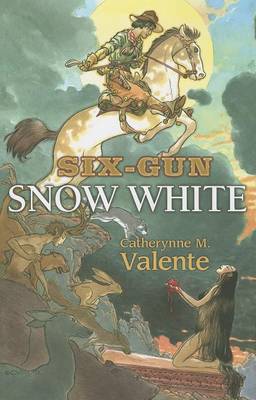Reviewed by nannah on
Content warnings:
- self harm
- suicide attempt (on page)
- fetishization
- racism
- torture
rape
- ableism & ableist slurs
Representation:
- the protagonist is a sapphic Crow woman (bi?)
- a secondary character is disabled (he has deer legs; the text makes a disability metaphor)
Snow White is the child of a Crow woman and a wealthy silver (and sapphire and diamond and anything that shines) baron. After her mother dies, she grows up alone in a palace by the sea with a red pearl-inlaid revolver until her father decides to marry again. Mrs. H is nothing like her mother. She names Snow White after the one thing she could never be and abuses her until she runs away. But Mrs. H won’t let her go so easily, and Snow White knows she can’t rest on her journey to meet her mother’s people.
Okay, so I do have some understanding of what this book is about (or at least my own interpretation of it … because it may not be what the author truly had in mind), and it does make sense in a wacky sort of way. And I have a great appreciation for Catherynne M. Valente’s talent with words. She really is a masterful writer. Some of those phrases, the imagery, the similes (although, let’s be honest, there were a lot of them!) are absolutely gorgeous. This all is what brought the rating up to two stars.
Besides appreciating the actual craft of the writing itself, I didn’t enjoy reading this novella. A book can have dark, depressing, disturbing, frightening themes, and themes about difficult-to-read topics without crossing a line. I might be in the minority here, but I think this one here crosses that line. As a white author, maybe Catherynne M. Valente shouldn’t have spent a third of the novella torturing her indigenous protagonist. Snow White’s white stepmother compares Snow white (and her body parts) to animals, uses racist imagery and language, bathes her and nearly drowns her in milk to “purify” and lighten her inside and out, and mentions several times that this was the only way Snow White could become an actual human woman. While the rest of the novella is in a different PoV with a summary-style narrative voice, the first third is in Snow White’s own head describing things in real time. The novella is as much about Snow White being biracial and not fitting in with either white people or her own Crow people as it is anything else -- and while it’s okay for white writers to write characters of color, I don’t think writing a book about racial struggles is appropriate (then again, though ... I'm white, so).
But obviously I don’t think she did this with malicious intent, especially after looking up the author a little bit and seeing how people talk about her. She genuinely seems to be a decent person.
It was just very, very difficult to get through this one, and for such a short work it took me ages.
Reading updates
- Started reading
- 16 December, 2021: Finished reading
- 16 December, 2021: Reviewed
